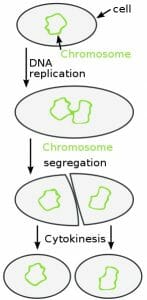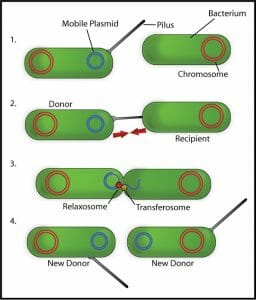Binary fission is an asexual reproduction process that prokaryote organisms use to duplicate themselves. There is no exchange of genetic information between organisms during binary fission, so over time, populations can experience a lack of genetic diversity. To overcome this, one of the ways that prokaryotes like bacteria have developed to add genetic diversity to their DNA is conjugation. In this process, bacteria come into contact with each other by using hair-like structures called pili that are on the surface. Through a single pilus, one of the bacteria can transfer a DNA plasmid to the other. Two other methods that prokaryotes use to transfer DNA are transformation (they take up a fragment of DNA from the environment) and transduction (a piece of DNA is injected into the bacteria by a bacteriophage).
Comparison Chart
| Binary Fission | Conjugation | |
|---|---|---|
| What is it used for? | Duplication of an organism | DNA transfer between organisms |
| Used by prokaryotic organisms? | Yes | Yes |
| Used in sexual reproduction? | No | No |
| Recent adaptation? | No | No |

The image above shows the process of binary fission.

The image above shows how a bacterium uses a pilus to conjugate with another bacterium.
References
- Fission (biology). (n.d.). In Wikipedia. Retrieved June 13, 2017 from https://en.wikipedia.org/wiki/Fission_(biology)
- OpenStax, Biology. OpenStax. May 20, 2013. http://cnx.org/content/col11448/latest/
Compare and Contrast Binary Fission and Conjugation
No comments:
Post a Comment